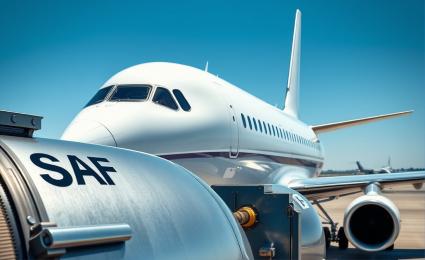This podcast episode explores the development of green products and examines the dual aspects of financing sustainability.


Contrails: A solvable problem?
Understanding and managing contrails: A path to reducing aviation's climate impact
Contrails, the thin, wispy clouds formed by aircraft at high altitudes, have long been a familiar sight in the skies. However, their role in climate change is increasingly coming under scrutiny. While aviation’s contribution to global CO2 emissions is well-documented, contrails and their associated cloud formations may have an even greater impact on global warming.

"Navigational avoidance solutions could reduce aviation’s climate impact at a limited cost."
As research evolves, so too does the search for viable solutions to mitigate this effect. The good news? Strategies are emerging that could significantly reduce contrails' climate impact without drastically altering aviation operations.
The climate challenge of contrails
Contrails form when hot engine exhaust mixes with cold, moist air at high altitudes, leading to ice crystal formation. While these clouds can sometimes reflect sunlight away from Earth, their net effect—especially at night—is to trap outgoing heat, contributing to global warming. The extent of this impact is still being quantified, but some estimates suggest contrails could account for a climate-warming effect equal to or greater than that of aviation’s CO2 emissions.
The challenge with contrails is their variability. Not all flights create them, and their impact depends on atmospheric conditions. Because contrail formation is influenced by humidity, temperature, and pressure, a more precise understanding of these factors can lead to better mitigation strategies.
Potential solutions to reduce contrail impact
While eliminating contrails entirely is unlikely, several mitigation strategies have been identified:
- Engine efficiency improvements: Advances in engine technology can reduce soot emissions, which serve as nuclei for ice crystal formation. More efficient combustion could result in fewer or less persistent contrails. However, modifying engine designs to address contrails specifically presents trade-offs, such as changes in fuel burn that could offset the benefits.
- Novel fuels: The composition of fuel plays a role in contrail formation. Sustainable aviation fuels (SAFs), particularly those with lower aromatic content, produce fewer soot particles, reducing the density of contrails. While promising, widespread SAF adoption faces hurdles, including production scale, cost, and regulatory support.
- Flight path adjustments: One of the most effective short- to medium-term strategies involves optimizing flight paths to avoid ice-supersaturated regions where contrails form. This could involve small altitude changes or minor route adjustments that have minimal impact on fuel efficiency. The challenge lies in integrating contrail avoidance into real-time flight planning without significantly increasing operational costs.
Implementing contrail mitigation
A new study by Roland Berger looks in more detail at these three options, with a particular focus on the potential for avoiding contrail-forming regions – the most viable solution in the medium term.
Two aviation technology companies, SATAVIA and FLIGHTKEYS, are at the forefront of contrail management efforts. Our study looks at their ongoing work to validate and implement their solutions.
SATAVIA leverages advanced atmospheric modeling to predict contrail formation. By providing airlines with optimized flight paths that minimize contrail impact, SATAVIA has demonstrated the feasibility of reducing contrail-induced warming without significant operational disruptions.
FLIGHTKEYS incorporates contrail forecasts into its flight planning systems. Using real-time data, it helps airlines adjust routes to minimize warming effects while maintaining cost-effectiveness and efficiency.
Early trials from these companies indicate that strategic flight adjustments can reduce contrail formation by over 50% with a relatively small increase in fuel consumption – often below 2%.
Adoption of technological solutions such as these will depend on a variety of economic and regulatory factors. Airlines must balance operational efficiency with sustainability initiatives, for instance, while the European Union and other global bodies are exploring policies to encourage contrail management as part of broader decarbonization efforts. Future frameworks may include incentives for airlines that implement contrail mitigation strategies, much like existing carbon credit programs.
Looking ahead: Greater collaboration is essential
Contrails represent a significant but solvable component of aviation’s climate impact. With better predictive models, targeted flight adjustments, and cleaner fuels, substantial progress can be made. However, industry-wide collaboration is essential. Airlines, regulators, and technology providers must work together to refine mitigation strategies and integrate them seamlessly into everyday operations.
In the coming years, as research deepens and solutions become more refined, managing contrails could become a standard component of sustainable aviation practice – helping the industry take a major step toward reducing its environmental footprint while maintaining safe and efficient operations.
For more detailed information on this topic, download our latest study into reducing contrails’ climate impact.
We would like to thank Christopher Stern, Miguel Lopez, and Yimian Tang for their contribution to this publication.
Register now to access the full study and explore more about reducing aviation's climate impact through smarter flight paths. Furthermore, you get regular news and updates directly in your inbox.

_person_144.png?v=770441)




_person_320.png?v=770441)




_person_320.png?v=1495835)